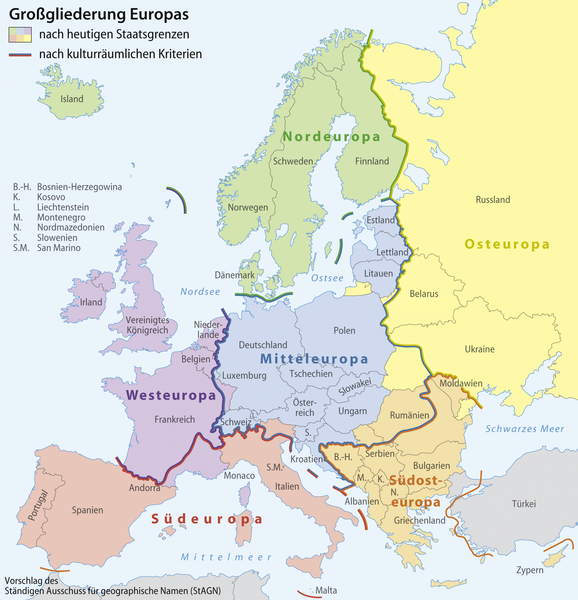te pol solo che scieglier, quel che te fa comodo te ciol, e quel che no te piasi te scarti come ignorante... ecco un altra
dalla medesima pagina

e ghe xe questo passo, tradusi o fatte tradur
Geschichte des Begriffs Mitteleuropa [Bearbeiten]
Der Begriff Mitteleuropa war zunächst ein politischer Begriff, der jedoch unterschiedlichen Zielsetzungen gedient hat. Er kam in der Mitte des 19. Jh. auf, als Constantin Frantz eine Föderation „Mitteleuropa“ aus Deutschland, Polen und Donauslawen vorschlug, um ein Gegengewicht zu den Großmächten Russland und Frankreich zu schaffen. Ähnliche Ideen waren auch in der Nationalliberalen Partei verbreitet, so bei Friedrich List und Heinrich von Gagern, die ein deutsch-österreichisch geführtes Mitteleuropa von Hamburg bis Triest propagierten.
opur de un'altra pagina wiki:

con questo comento che me par appropriato
Central Europe is the region lying between the areas of Eastern and Western Europe. In addition, Northern, Southern and Southeastern Europe mean different regions, but in some way they may or overlap into Central Europe. The term has come back into fashion since the end of the Cold War, which had divided Europe politically into East and West, with the Iron Curtain splitting "Central Europe" in half.
The understanding of the concept of Central Europe varies considerably from nation to nation, and also has from time to time.
Mi sottoscrivo l'ultima frase.
Mi diffido un poco de certe definizioni de Mitteleuropa, per una question storica, che trovo in un passo de una bozza de Wiki
Germany and Austria-Hungary's claims to the lands of "Mitteleuropa" in World War I and success in attaining them in 1918, would lay the foundation of the concept of Lebensraum (living space) by the Nazi regime years later.
e anche per questo articolo, che me lassa una fiadin diffidente nei confronti de un zerto revival mitteleuropeo contemporaneo:
http://www.springerlink.com/content/p33x464j54556706/
da cui riporto questo passo
Abstract The analysis in this article addresses the
resurfacing of Mitteleuropain the populist discourse or, more precisely, the use of Mitteleuropa-ideas in the political strategies of the Austrian FPÖ (Austria's right-wing `Freedom Party'). The plans of the future European assessment spread by the European right-wing populism have an ambiguous character, which partly
reproduces the ambiguity of the traditional definitions of Mitteleuropa in the debate at the beginning of the twentieth century. The article shows that the FPÖ's use of the concept of Mitteleuropa must be analysed with regard to the problem of the Austrian identity, because the ambiguous status of an ‘Austrian identity between Mitteleuropa and German re-union’ is the most important condition underpinning the emergence of the FPÖ. Secondly, the choice of a particular idea of Mitteleuropa - the Mitteleuropa defined by principles of exclusion, by a strong German culture and identity (Kulturnation), and strict reference to a Volksgemeinschaft with a territory and a culture that are juxtaposed to a cosmopolitan and liberal idea of Mitteleuropa- reveals the FPÖ's historical legacy and its
opposition towards democracy and the representative institutions.







